Order of Dannebrog, (1671-1808), Collar
SKU: 01.DNK.0103.101.01
Estimated market value:
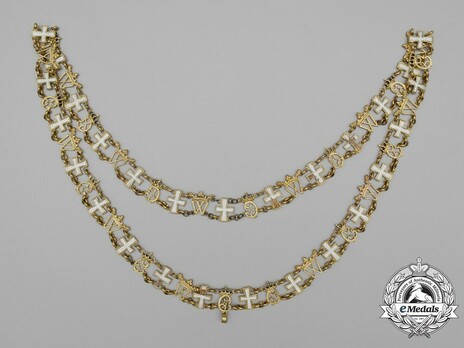
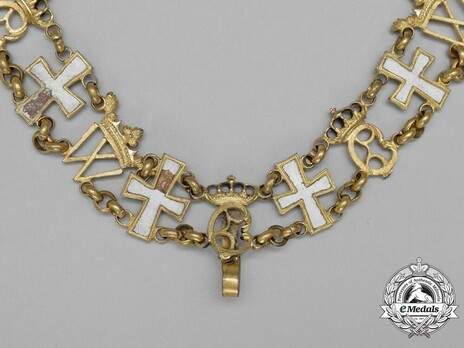
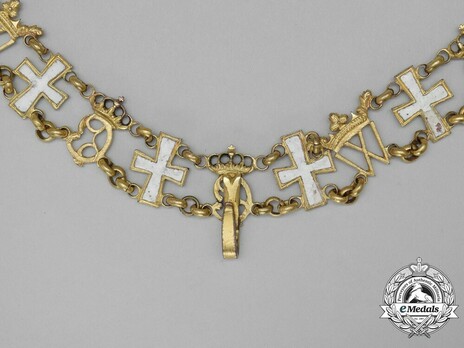
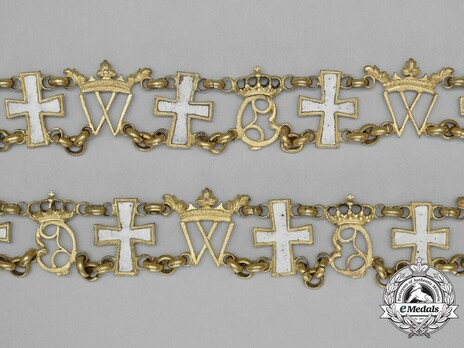
Estimated market value:
Attributes
History
Believed to have originally been established by King Waldemar II in 1219, and later re-instituted by King Christian V, in honour of the birth of his first son (King Frederik IV) in 1671, this Order originally consisted of one class and was conferred upon noblemen, princes of royal blood, and high dignitaries. There is no evidence of this Order being established by King Waldemar II, although the current decorations continue to consist of his cypher as well as the year 1219. Originally the order consisted of one class only.
The cypher changes on the decoration based on the reigning King, excluding the original badge before 1801. The types in MedalBook are as follows:
1671-1808 (explained more thoroughly below).
Frederic 6 (1808-1839): F VI
Christian 8 (1839-1848): C VIII
Frederic 7 (1848-1863): F VII
Christian 9 (1863-1906): C IX
Frederic 8 (1906-1912): F VIII
Christian 10 (1912-1947: C X
After 1952
This Order was revised by King Frederick VI in 1808, adding four new classes, and was then awarded to any Danish man without restrictions to age or his rank. The new classes were as follows: Grand Commander; Grand Cross (which may be in diamonds); Commanders; Knights; Silver Cross (the awardees of these were not knights).
To date, the Order is awarded to recognize individuals who have rendered outstanding, commendable, and distinctive military or civil service, as well as, contribution to the sciences, arts, or business.
Reformations to this Order have all contributed to the many versions of each award. All crosses of the Order are surmounted by the monogram of the monarch who granted it, this excludes the original badge before 1801.
Women were admitted to this Order in 1951 and wear badges on a bow, whereas men wear it on neck ribbons.
The Order insignia is returned to the throne upon death.
The First Period in MedalBook consists of the collar and cross. The crosses have the following cypher depending on the time period:
Christian V (1671-1699): C5
Frederic IV (1699 -1730): F4
Christian VI (1730-1746): C6
Frederic V (1746-1776): F5
Christian VII (1766-1808): CVII
The Breast Star is inscribed RE STI TU TOR C5.
In Frederic IV (1808-1839) had embroidered stars to be paired with the Grand Commander, Grand Cross and Commander classes. There are four different varieties of the IV class knight. One has the reverse inscription reading 1808, while the other has 1818. There are six different varieties of the silver cross.
In Chrisitian VIII (1839-1848), the Grand Commander is no longer referred to as the I Class. In 1842, the rank of the Grand Commander was declared as a special class, that was only awarded to members of the Royal house. Therefore the Order was altered to be: Grand Commander, I Class Grand Cross, II Class Commander, and III Class Knight, along with the silver cross. The Grand Commander Star may be embroidered or with diamonds. This order remained for Frederic VII.
In 1861 the Commander class of the Order was divided into two grades: with and without a breast star.
In Christian IX (1863-1906), a II Class II Grade Commander (neck cross only) was instituted.
In 1912, it was decided that in cases where the Grand Cross was to be awarded with diamonds, the diamonds should be newly worn on the star as opposed to the badge.
The Knight class was also divided into two grades in 1952: the Gold Cross and Silver Cross. The Gold cross was identified by a rosette on the ribbon.
The Collar remains the same through each type. It is composed of alternating links of gold crosses, enamelled white with red edges, between crowne C5 and W cyphers. The collar had to be purchased by the recipient and therefore is not often in gold. Older collars were often composed of silver gilt and enamel. From the 1800’s most of the collars were composed of lacquered bronze gilt.
Chains are commonly passed down to the successor rather than recreated.
There is ambiguity concerning the recipients of the collar due to the proliferation of amendments of this Order over history.

Versions
$12000+ USD
Bronze gilt/Enamelled
13200mm
This collar weighs 168 grams.
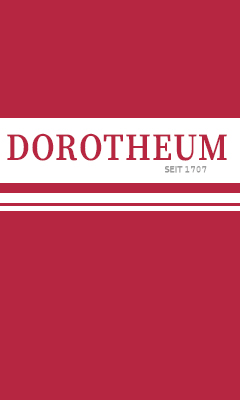
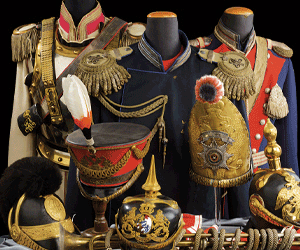
Comments
Sign in to comment and reply.


Scroll Top